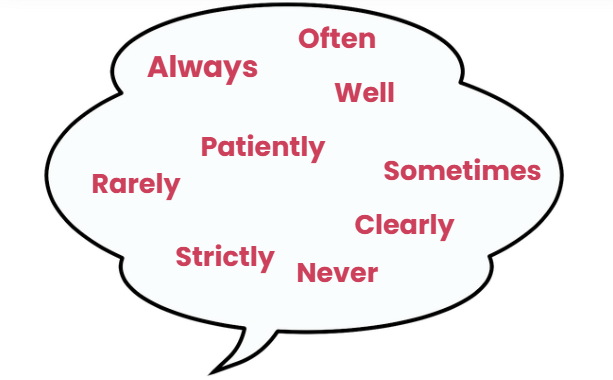Worksheet Solutions: Adverb -1 | English Grammar for Junior Classes - Class 1 PDF Download
Q1: Underline the adverb in the following sentences.
(i) We must eat our food slowly.
Ans: We must eat our food slowly.
(ii) The woman spoke loudly.
Ans: The woman spoke loudly.
(iii) You have done your lesson well.
Ans: You have done your lesson well.
(iv) The horse galloped fast.
Ans: The horse galloped fast.
(v) The play will begin now.
Ans: The play will begin now.
(vi) My uncle lives here.
Ans: My uncle lives here.
(vii) Gopal is standing there.
Ans: Gopal is standing there.
(viii) We should always speak the truth.
Ans: We should always speak the truth.
(ix) The servant is paid monthly.
Ans: The servant is paid monthly.
(x) I feel tired today.
Ans: I feel tired today.
Q2: Fill In The Blanks With The Correct Adverb Of Time From The Box.
 (i) How many times did she give you homework?
(i) How many times did she give you homework?
Ans: always
(ii) How did she listen to your problems?
Ans: patiently
(iii) How did she speak while teaching?
Ans: clearly
(iv) How many times did she allow you to play games?
Ans: sometimes
(v) How many times did she point out your faults?
Ans: never
(vi) How many times did she get angry?
Ans: rarely
(vii) How many times did she smile?
Ans: often
(viii) How did she teach?
Ans: well
Q3: Determine what adverb the following underlined words are describing.
(i) Jeremy quickly ate his lunch.
Ans: how
(ii) Kaylee often reads books about vampires.
Ans: when
(iii) Olivia immediately came to the rescue.
Ans: when
(iv) When will you come here to visit us?
Ans: when
(v) Marcus slowly walked to the barbershop.
Ans: how
(vi) Sometimes Martin goes to the museum.
Ans: when
(vii) Please speak clearly.
Ans: how
Q4: Determine the type of adverb used in the following sentences (e.g., Adverb of Manner, Time, Place, Frequency, or Degree)
(i) She often goes for a walk in the evening.
Ans: Adverb of Frequency
(ii) The children played happily in the garden.
Ans: Adverb of Manner
(iii) We will leave tomorrow morning.
Ans: Adverb of Time
(iv) He is almost finished with his work.
Ans: Adverb of Degree
(v) They searched everywhere for the missing keys.
Ans: Adverb of Place
|
18 videos|305 docs|31 tests
|
FAQs on Worksheet Solutions: Adverb -1 - English Grammar for Junior Classes - Class 1
| 1. What is an adverb and how is it used in a sentence? |  |
| 2. Can you provide examples of different types of adverbs? |  |
| 3. How do adverbs differ from adjectives? |  |
| 4. Are there any rules for placing adverbs in a sentence? |  |
| 5. How can I identify adverbs in a text? |  |
















